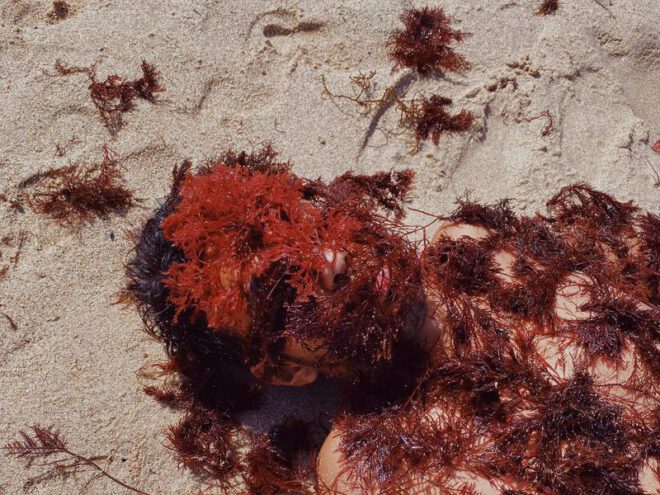One of Morocco’s most valuable exports is red gold algae, from which the gelling agent agar-agar is made. Agar-agar has multiple uses in health supplements, cosmetics, pharmacology, and other industries. We wrote about algae as treatment for inflammatory bowel disease here.
Morocco has imposed quotas, and set prices on the valuable seaweed, but until now the government hasn’t considered the looming consequence of over-harvesting it: extinction.
Harvesting red gold algae also involves the backbreaking labor of seasonal workers who are paid shockingly little.
Five UK and Moroccan artists have mounted an exhibition in London focused on red gold algae to illustrate human and ecology issues. Called Red Gold Reflections, it incorporates essay films, recorded performances, sound installation, and photography.

The National (UK) interviewed Sabrina Mumtaz Hasan, one of the artists involved in the collaboration. She is an associate lecturer on the MA Art and Science course at Central St Martins.
“Agar-Agar was promoted as a replacement for gelatin and as bioplastics in design, and was meant to be more sustainable, but it is also problematic because there isn’t really a ‘golden product’ that solves environmental problems,” she said.
Mumtaz Hasan traveled to Morocco to view a company that cultivates microalgae destined to develop into macroalgae.
Susewi, with its partner Plymouth University, received funding from Innovat UK to develop technology and structure of a project where microalgae grow in a large pond donated by the Moroccan government near the town of Akhfennir. The artificial pond, set in non-arable land, occupies three hectares and is the largest algae pond in the world. Seeing the success of the experiment, the Moroccan has since allocated another 6000 hectares to build another plant.
“They’re working with single-cells to multiply them, which takes out the need to harvest from the sea,” says Mumtaz Hasan.
Susewi’s CEO Keith Coleman states that the company’s goal is to become “The world’s largest producer of algal biomass. Microalgae,” he continues, “are the “most successful organisms on the planet.” They grow ten times faster than land plants and absorb CO2 more efficiently than trees do. They don’t need soil, which allows use of non-arable land, while converting sunlight into food. Can algae be the new superfood?
The Algal Innovation Centre at the University of Cambridge is the second UK-based body cultivating algae, feeding the micro-plants nutrients extracted from fruit and vegetable waste.
Mumtaz Hasan said, “I was quite skeptical when I went to speak to both labs, but this process has been very enlightening.”
The Red Gold Reflections exhibition hopes to bring about discussion on climate change and sustainable practice. It ran at P21 Gallery, London ran until November 6, but a series of Red Gold Reflection online events may be viewed through Dardishi.
The collaboration was the fruit of a three-month research and artistic residency run by A.Mal, an artistic research collective funded by the British Council Morocco and Arts Council England.
Photo “Evanescence” via P21 Gallery.
Photo of red-gold algae harvester via AFP.

